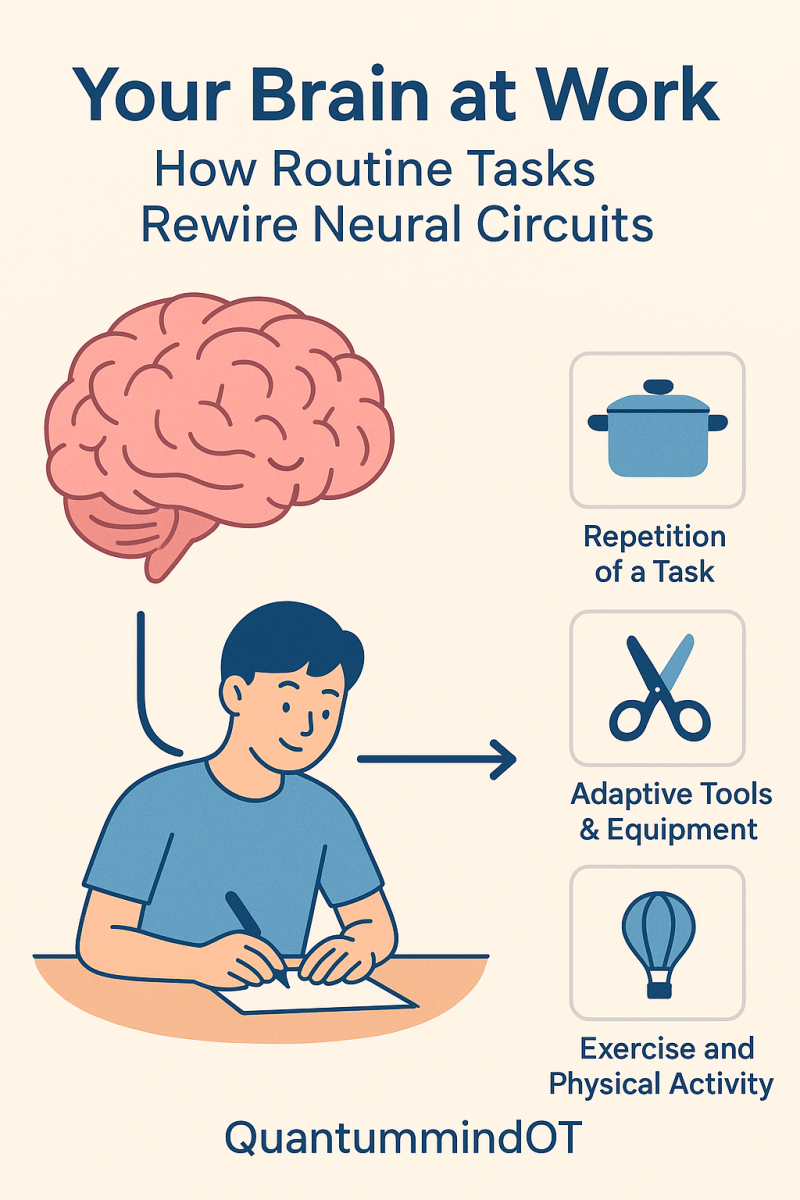By Syeda Rizvi

Overview
Our brains are dynamic ecosystems rather than static devices. Neural circuitry is literally altered by every action, habit, and new ability. By assisting clients in meaningful, repetitive activities that promote healing, development, and well-being, occupational therapy (OT) takes advantage of this brain adaptability, also known as neuroplasticity. Whether it’s tying shoes, cooking, or exploring new experiences, even seemingly simple tasks can strengthen neural connections, helping the brain reorganize and adapt.
How Neuroplasticity Works:
The brain's capacity to rearrange itself by creating or fortifying neuronal connections in reaction to experience, education, or trauma is known as neuroplasticity.
Source: Barrett, L. (2024) Occupational neuroplasticity: A new lens for brain rehabilitation. OT Corner. Available at: https://barrett.com/ot-corner/2024/10/1/occupational-neuroplasticity (Accessed: 30 July 2025).
This adaptable rewiring affects all aspects of life:
-
Motor skill development
-
Cognitive growth
-
Emotional regulation
-
Recovery from injury or stroke
Recent neuroscience highlights include:
-
The NIH BRAIN Initiative mapping the first comprehensive adult fruit-fly connectome with 50 million neuronal connections.
-
Studies identifying new brain-immune interfaces, such as dural-associated lymphoid tissue (DALT), showing interactions between CNS and immune systems.
These findings underscore how daily experiences and therapy interventions can tangibly reshape neural circuitry.
In 2024, NIH-funded neuroscience initiatives have advanced significantly:
In order to provide translational insights into brain circuitry and neural pathfinding, the NIH BRAIN Initiative, for instance, recently revealed the first comprehensive adult fruit-fly connectome, mapping 50 million neuronal connections.
Source: Frontiers in Human Neuroscience (2024) Virtual reality for stroke rehabilitation: A systematic review and meta-analysis. Frontiers in Human Neuroscience, 18, 1540391. Available at: https://www.frontiersin.org/articles/10.3389/fnhum.2024.1540391/full (Accessed: 30 July 2025).
New mechanisms in CNS immune regulation were revealed by other NIH-backed studies that investigated brain-immune interfaces, such as the identification of dural-associated lymphoid tissue (DALT).
Source: NIH National Institute of Neurological Disorders and Stroke (NINDS) (2024) Reflecting on 2024: Advancing neuroscience research to improve neurological health. Available at: https://www.ninds.nih.gov/news-events/directors-messages/all-directors-messages/reflecting-2024-advancing-neuroscience-research (Accessed: 30 July 2025).
Daily Jobs as Instigators of Brain Development
1. Repetition of a Task:
OT uses purposeful, repeated actions that trigger synapse strengthening and functional rewiring, such as cooking, folding laundry, and tying shoes. These form the basis of the "ten principles of neuroplasticity" that are applied in neurological rehabilitation.
Source: American Occupational Therapy Association (AOTA) (2024) Applying principles of neuroplasticity to everyday neurological rehabilitation. OT Practice. Available at: https://www.aota.org/publications/ot-practice/ot-practice-issues/2024/applying-principles-of-neuroplasticity-to-everyday-neurological-rehabilitation (Accessed: 30 July 2025).
2. Adaptive Tools & Equipment:
Adapted cutlery and handwriting assistance are examples of assistive technologies that allow clients with disabilities to participate in tasks in a meaningful way. By practicing with these tools, the brain gains control over new motor patterns, resulting in neuroplastic change.
Source: Constantinovici, M.-I., Poenaru, D., Nartea, R. & Cinteză, D. (2025) ‘Low‑Tech and High‑Tech Assistive Tools for Occupational Therapy and Hand Rehabilitation in Patients with Upper‑Extremity Sensorimotor Impairment and Disability’, Journal of Alternative, Complementary & Integrative Medicine, 11(1), p.543. doi: 10.24966/ACIM‑7562/100543.
3. New and Inspiring Settings:
Learning a language or exploring sensory-rich settings are examples of novel experiences that stimulate the creation of new brain pathways. Developing interesting, diverse work experiences for OT clients promotes their brain and cognitive flexibility.
Source: Center for BrainHealth (2024) Neuroplasticity and your brain. Center for BrainHealth. Available at: https://centerforbrainhealth.org/article/neuroplasticity-and-your-brain (Accessed: 30 July 2025).
4. Exercise and Physical Activity:
Frequent aerobic exercise raises neurotrophic factors such as VEGF, IGF-1, and BDNF, which improve executive function and the volume of the hippocampus and prefrontal cortex. Movement enhances brain reorganisation when paired with intentional activity.
Source: Kraemer, R.R. & Kraemer, B.R. (2023) ‘The effects of peripheral hormone responses to exercise on adult hippocampal neurogenesis’, Frontiers in Endocrinology, 14, p.1202349. doi: 10.3389/fendo.2023.1202349.
5. Technology-Assisted Intervention:
By providing immersive, task-specific experiences, virtual reality (VR), computer-mediated practices, and neuromodulatory techniques amplify neuroplastic effects. Immersion VR may be more effective than traditional therapy for stroke rehabilitation, particularly in upper-limb function, according to a 2024 systematic study. Imaging studies funded by the NIH continue to demonstrate how specific interventions encourage rewiring that is visible on fMRI or DTI scans.
Source: Soleimani, M., Ghazisaeedi, M. & Heydari, S. (2024) ‘The efficacy of virtual reality for upper limb rehabilitation in stroke patients: a systematic review and meta-analysis’, BMC Medical Informatics and Decision Making, 24, p.135. doi: 10.1186/s12911-024-02534-y.
💡 Practical Tips: Applying Neuroplasticity in Daily Life
-
Break tasks into small, meaningful steps as repetition matters more than intensity.
-
Incorporate movement and sensory engagement while performing routines.
-
Use adaptive tools to support independence and confidence.
-
Try novel experiences weekly to stimulate cognitive flexibility.
-
Pair technology-based interventions such as VR games, apps with hands-on practice for enhanced outcomes.
Even small, consistent changes in daily routines can lead to measurable improvements in brain function.
Conclusion:
Challenge, repetition, and meaningful involvement are what the brain thrives on. Through occupational therapy, we help clients remodel their neural circuits and improve their quality of life by utilising ordinary chores, adaptive tools, exercise, new experiences, and technology.
Because your everyday routines involve mental as well as physical exercises, we at QuantummindOT think that every tiny, deliberate action adds to a healthier, more flexible brain.


Add comment
Comments